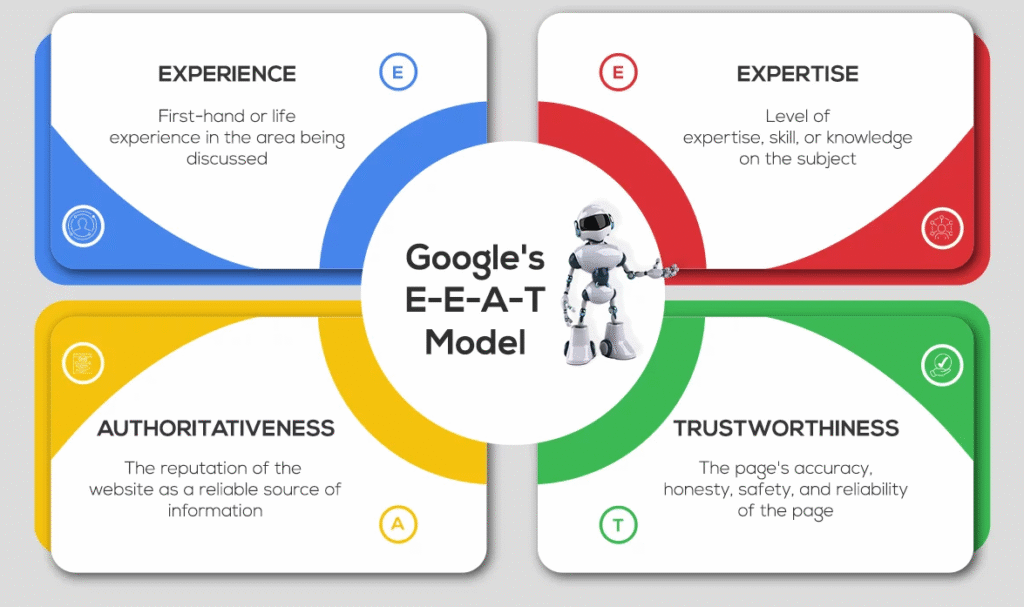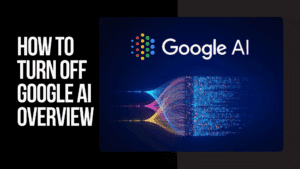AI-generated content is booming—quick to produce, scalable, and surprisingly well-written. But here’s what most creators miss: if your content isn’t aligned with Google’s E-E-A-T guidelines, your rankings could be on borrowed time.
In late 2022, Google expanded its quality framework to E-E-A-T—adding Experience to Expertise, Authoritativeness, and Trust. This wasn’t a minor tweak. It was a direct response to the surge of generic, AI-written content lacking firsthand insight or credibility.
Even if your AI content hits the right keywords, it may still fall flat without the human signals Google now prioritizes.
In this article, you’ll learn why AI content and E-E-A-T go hand in hand—and how failing to connect the two could cost you visibility. We’ll cover:
- Why AI content often struggles with E-E-A-T
- What Google really looks for in trustworthy content
- Actionable ways to build authority, expertise, and experience—even with AI
Let’s dive in and future-proof your content strategy.
What Is E-E-A-T and Why It Matter More Than Ever

Google’s E-E-A-T framework—Experience, Expertise, Authoritativeness, and Trustworthiness—isn’t just SEO jargon. It’s a core part of how Google determines whether your content deserves to rank. And with the rise of AI-generated content, it’s become even more crucial.
Breaking Down E-E-A-T
- Experience: Does the author have real, hands-on knowledge of the topic? Google now values lived experience, especially in niches like health, finance, and product reviews.
- Expertise: Is the content created or reviewed by someone with subject matter knowledge? This is critical for “Your Money or Your Life” (YMYL) topics, where misinformation can be harmful.
- Authoritativeness: Is the website or author recognized as a credible source in their field? Backlinks, mentions, and consistent high-quality publishing play a role here.
- Trustworthiness: Can users rely on the accuracy, transparency, and integrity of your content? Clear citations, privacy policies, and responsible sourcing are key trust signals.
Google’s Search Quality Evaluator Guidelines explicitly mention E-E-A-T as the lens through which content quality is judged.
Why E-E-A-T Is Now the Barrier to Ranking AI Content
As AI tools flood the web with auto-generated articles, Google’s focus has shifted from simply detecting quality writing to identifying signals of real-world credibility. That’s why content that lacks experience or comes from unknown authorship is at a growing disadvantage.
You might be using AI tools like ChatGPT, Claude, or Writesonic to create impressive content quickly. But if your article has no human voice, authority signals, or trustworthy sourcing, Google’s algorithms—and manual reviewers—are likely to skip over it.
Pro Tip: AI-written content isn’t penalized for being AI-generated. It’s penalized when it lacks the quality signals E-E-A-T demands.
How AI-Generated Content Challenges E-E-A-T
AI can write fast. But writing well—in a way that convinces both humans and Google of your expertise, authority, and trustworthiness—is where things get tricky.
While AI tools can mimic tone, summarize research, and even follow SEO prompts, they struggle to deliver the very thing E-E-A-T demands: human depth.
The Three Major Gaps in AI-Generated Content
1. Lack of Real-World Experience
AI doesn’t live—so it can’t share first-hand insights, personal anecdotes, or genuine observations. This makes your content sound generic, even if it’s grammatically perfect.
Example: An AI can describe how a DSLR camera works, but only a real photographer can explain how it performs during a night shoot in the rain.
2. Questionable Expertise
While AI pulls from a wide pool of online data, it often lacks context or judgment. It may confidently present outdated, incorrect, or oversimplified information.
This is especially dangerous for YMYL (Your Money or Your Life) content like medical advice, legal tips, or financial strategies.
3. Weak Trust Signals
AI content is often published anonymously or under fake author names, with no clear accountability. That lack of transparency hurts trustworthiness, a core E-E-A-T pillar.
According to Google’s guidance on AI-generated content, content should be evaluated on quality—not authorship—but who is behind the content still matters, especially in competitive or sensitive niches.

Can AI Content Ever Be E-E-A-T Compliant?
Yes—but not alone.
AI is a powerful tool, not a replacement for genuine authority or thoughtful storytelling. When used correctly, it can help creators scale their output, but it must be paired with:
- Expert oversight
- Verified sources
- Real human insights
That’s how you build trust and meet E-E-A-T compliance for AI content.
Aligning AI Content and E-E-A-T: A Strategic Framework
Creating high-performing AI content isn’t just about keywords and formatting—it’s about building credibility, depth, and transparency into every article. Here’s how you can make sure your content hits all the right E-E-A-T signals while still using the speed and efficiency of AI.
1. Assign Human Oversight
AI can generate a first draft, but it takes a human to refine the message, add nuance, and ensure accuracy.
- Have subject matter experts review or co-write AI content.
- Add a byline and author bio with real credentials.
- Include editor’s notes or human-reviewed tags to boost transparency.
Example: Use an AI tool to draft a blog post, then have a certified nutritionist fact-check and add lived insights. The result? Content that’s informative and credible.
2. Incorporate Authoritative Citations
Google favors content backed by reliable sources. AI doesn’t always get this right—so step in and add citations manually.
- Link to trusted domains like CDC, Harvard Business Review, or Statista.
- Use hyperlinks to embed credibility into claims—don’t list all your sources at the end.
- Ensure that data and stats are up-to-date and from primary sources.
Tip: When optimizing for E-E-A-T compliance for AI content, always vet the AI’s “facts” before publishing.
3. Layer in Real Experience
Injecting personal stories or first-hand examples strengthens both experience and engagement.
- Include personal case studies, customer feedback, or firsthand reviews.
- Add screenshots, timelines, or behind-the-scenes insights.
- Use real quotes from interviews or experts in your network.
Example: Instead of just saying “This tool improves workflow,” describe how your team saved 4 hours weekly using it—and show the before/after data.
4. Clarify Accountability
AI content without a clear human voice often feels robotic, and Google notices.
- Always publish content under a real person’s name with a visible author bio.
- Link author bios to professional sites or LinkedIn for added trust.
- Add a “last updated” date and editorial review credits to demonstrate content maintenance.
Bonus: Include structured data like
author,publisher, andreviewedByschema for SEO and E-E-A-T alignment.
Together, these strategies turn raw AI output into search-ready, E-E-A-T optimized content that Google can trust—and rank.

AI-Generated Content SEO Best Practices That Reinforce E-E-A-T
Once your content aligns with E-E-A-T, the next step is making sure it’s fully optimized for search engines. Here are key AI-generated content SEO best practices that naturally reinforce trust, authority, and visibility.
1. Use Schema Markup to Validate Content Credibility
Structured data helps Google understand the who, what, and when behind your content.
- Use
Author,Publisher, andReviewschema to highlight expertise and accountability. - Add
FAQPageorHowToschema for instructional content to improve click-throughs and feature eligibility. - Keep schema updated with fresh metadata to signal ongoing content maintenance.
Tools like Merkle’s Schema Generator or Schema.org can help you implement this easily.
2. Target Low-Competition, High-Intent Keywords
AI content is ideal for covering long-tail queries—but you must choose your battles wisely.
- Use tools like Ubersuggest, LowFruits, or Keyword Chef to find underserved topics.
- Look for keywords with informational or transactional intent that match your niche authority.
- Focus on building topical clusters to reinforce subject matter expertise.
Tip: Ranking for niche terms builds authoritativeness faster than chasing broad, high-difficulty keywords.
3. Prioritize Readability & UX
Google rewards content that offers a good user experience—fast, scannable, and easy to digest.
- Use short paragraphs, clear headers (H2, H3), and bullet points.
- Add visuals like charts, infographics, or screenshots to illustrate key points.
- Ensure fast load times, mobile responsiveness, and logical internal linking.
Readable content not only retains users but also encourages backlinks—another E-E-A-T win.
4. Update Content Regularly
Stale content signals neglect. Fresh updates show you care about accuracy and usefulness.
- Revisit and refresh AI-generated content every 3–6 months.
- Add new stats, quotes, or expert commentary to show evolving authority.
- Use “last updated” tags both visibly and in metadata.
Google values ongoing expertise, not just one-time effort.
When your AI-generated content follows these SEO best practices, you’re not just optimizing for search—you’re building a trustworthy brand presence that aligns with E-E-A-T standards.
Final Thoughts: Why Trust Is the Ultimate Ranking Signal
The rise of AI in content creation is undeniable—but so is Google’s evolving demand for trust, authority, and authenticity. If you’re producing AI-written articles without aligning them with E-E-A-T, you’re not just missing an SEO opportunity—you’re risking your rankings altogether.
The good news? You don’t need to abandon AI. You just need to humanize it, enhance it, and back it with real expertise.
Here’s a quick recap to stay ahead:
- Use AI to scale content—but add human oversight and experience.
- Optimize for SEO—without losing authenticity.
- Layer in trust signals—from schema to author bios—to show Google your content is credible.
Whether you’re a solo blogger or a digital agency scaling content with AI, E-E-A-T is no longer optional—it’s your foundation for sustainable search success.


